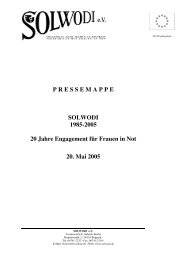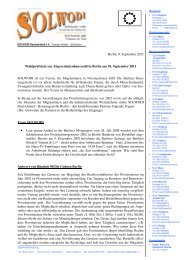Sponsored Vocational Training: Dream of Escape or Reality - Solwodi
Sponsored Vocational Training: Dream of Escape or Reality - Solwodi
Sponsored Vocational Training: Dream of Escape or Reality - Solwodi
You also want an ePaper? Increase the reach of your titles
YUMPU automatically turns print PDFs into web optimized ePapers that Google loves.
Efficacy <strong>of</strong> SOLWODI’s <strong>Vocational</strong> <strong>Training</strong> Scheme 4<br />
serious about staying in the sex industry <strong>or</strong> anxious to leave? Questions outweighed any answer<br />
I could find. I decided to travel back to Kenya to find out m<strong>or</strong>e.<br />
B. Kenya<br />
In <strong>or</strong>der to understand SOLWODI, its VT programme and its clientele, it is necessary to<br />
understand its context: Kenya. Kenya has a population <strong>of</strong> 34 to 39 million people (BMZ, 2009;<br />
CIA, 2009; GoK, 2009), <strong>of</strong> whom 51 percent are female. There has been a remarkable decline in<br />
fertility rates from 7.9 in 1979 to about 4.4 today. Blacker explains this decline with reference to<br />
urbanisation, greater contraceptive use and women’s education (Blacker, 2007). In Kenya,<br />
around 2.2 million are living with HIV, 700 people die every day <strong>of</strong> AIDS, and by 2002 there<br />
were around 1.2 million AIDS <strong>or</strong>phans. Life expectancy at birth f<strong>or</strong> the total population has<br />
fallen from 57 in 1990 to 48 in 2004, currently the most optimistic figures signify a life<br />
expectancy <strong>of</strong> 57 years again (BMZ, 2009; CIA, 2009; DfID, 2004).<br />
Most unemployed people are the youth. Owigar (2003: 8) attributes this to lack <strong>of</strong><br />
training, in particular in technical skills needed in the f<strong>or</strong>mal sect<strong>or</strong>. The current economic<br />
growth rate is estimated to be between 2.2 percent and 6 percent per year (GoK, 2009; CIA,<br />
2009). Per capita incomes declined during the 1990s resulting in an increase in poverty from<br />
48.8 percent in 1990 to 55.4 percent in 2001 (W<strong>or</strong>ld Bank, 2003). Poverty appears to be<br />
associated with large and female-headed households. Exogenous shocks relating to weather,<br />
international trade and regional security periodically exposes the economy to extreme<br />
vulnerability. An estimated ten million Kenyan are facing a food crisis as a result <strong>of</strong> crop failure,<br />
high food-prices, and the effects <strong>of</strong> election-related violence in early 2008 that disrupted farming<br />
activities. M<strong>or</strong>e women are turning to Sex W<strong>or</strong>k f<strong>or</strong> survival (PlusNews, 2009b).<br />
Kenya continues to rely heavily on a few primary commodity exp<strong>or</strong>ts, in particular tea,<br />
c<strong>of</strong>fee and h<strong>or</strong>ticulture. Although tourism is still an imp<strong>or</strong>tant exp<strong>or</strong>t earner, the sect<strong>or</strong> has<br />
suffered a steep decline over the past decade (DfID, 2004). Sex W<strong>or</strong>k is widespread in<br />
Mombasa, second largest city in Kenya, which has high levels <strong>of</strong> poverty, illiteracy and large<br />
numbers <strong>of</strong> international tourists, truckers and sail<strong>or</strong>s. Acc<strong>or</strong>ding to the 2004 United Kingdom’s<br />
Department f<strong>or</strong> International Development’s (DfID) analysis <strong>of</strong> drivers <strong>of</strong> change rep<strong>or</strong>t, Kenya<br />
will probably fail to achieve most <strong>of</strong> the Millennium Development Goals by 2015 (DfID, 2004).






